In 1895 the highly respected Yogi, Swami Sri Yukteswar (1855 – 1936) wrote an amazing book called The Holy Science, that was clearly ahead of its time. I bought the book it online. It was short and detailed, with crystal clear concepts. The purpose of the book was to remove barriers between all religions, especially Hinduism and Christianity. The book explains the astronomical movements of celestial bodies and it explains their calculation of the Yugas, or ages of man. Pundits have recently recalculated the Yugas, after an error was made several thousand years ago, which mistakenly led some people to believe we are still in the Kali Yuga period. Swami Sri Yukteswar is none other than the man who taught Yogananda, and sent Yogananda to the US, and therefore in great part responsible for the popularity of Yoga in the West. This article summarizes Sri Yukteswar’s calculations of the ages. Or you can read his book here.
Time Cycles in Nature
In order to understand the Yugas we first have to discover the planetary cycles. We already know that the days, months, and years on Earth are determined by the Earth’s rotation and orbit around the sun. Now we need to learn about the Sun’s orbit through the galaxy in a larger cycle called the Great Year.
What is The Great Year?
The Great Year is our Sun’s cycle through the solar system, that takes 25,800 years. NASA defines the Great Year as “The period of one complete orbit around the ecliptic, or about 25,800 years. This is also called the Platonic Year, as discussed by Plato, and the Precession of the Equinoxes, the name given by Isaac Newton.
How Did Ancient Astronomers Discover the Great Year Cycle?
Ancient astronomers found the Great Year by observing sunrise at the spring equinox each year in March. They had to get up very early on that morning, and carefully measure the position of the stars. On the horizon at sunrise there always appears one of these 12 zodiac constellations: Aries, Taurus, Gemini, Cancer, Leo, Virgo, Libra, Scorpio, Sagittarius, Capricorn Aquarius and Pisces. Every 2,150 years, a new zodiac sign appears on the horizon! That’s why Great Year is divided into 12 zodiac sub-cycles or Ages of 2,150 years each.
Ascension is Imminent and Ongoing, But Don’t Hold Your Breath.
About the 4 Yugas [4 Ages]
The four great epochs in Hinduism are: Satya Yuga, Treta Yuga, Dwapar Yuga and Kali Yuga. Satya Yug or the Age of Truth is said to last for four thousand divine years, Treta Yuga for three thousand, Dwapara Yug for two thousand and Kali Yuga will last for one thousand divine Years that equals to 432,000 earthly years.
It is also believed that three of these great ages have already passed away, and we are now living in the fourth one. What these ages exactly mean, and why this division, it’s hard to explain, because they appear too unrealistic to be true for the rational mind.
Isaac Newton believed this shift to be caused by a wobble in the Earth’s orbit. However ancient astronomers saw it simply as confirmation of a 25,800 year cycle. They also noticed that the cycle moves backwards through the zodiac signs! Each year’s position ‘precedes’ the previous year. Isaac Newton named this cycle The Precession of the Equinoxes, to describe this reverse movement.
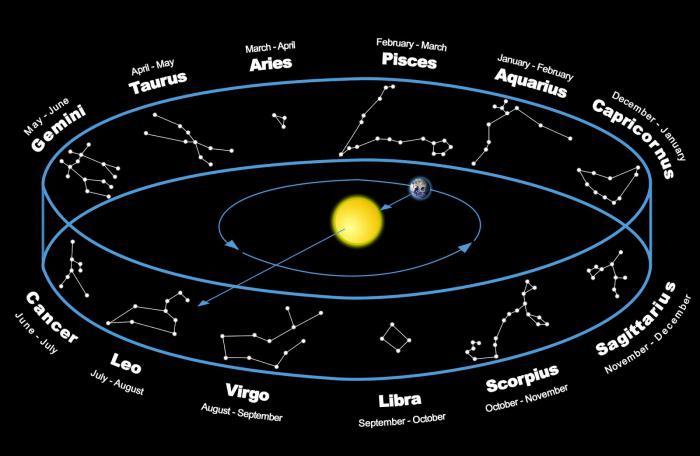
While modern thinking regards the Great Year as a phenomenon caused by the Earth’s wobbling axis, ancient cultures saw it as a natural indication of Earth’s place in galactic movement. Swami Sri Yukteswar presents a very different model of the Great Year from the “wobbly axis” we inherited from Isaac Newton.
Many Ancient Calendars Used Earth’s ‘Great Year’ Cycle, including the Greek, Inca, Chinese, Hindu, Egyptian, Mayan, and Hopi.
- The Greeks observed a ‘Platonic Great Year’ of 25,920 years in 5 Ages: the Golden, Silver, Bronze, Heroic and Iron Ages.
- The Hindu calendar has Yugas or ages: The Golden, Silver, Bronze and Iron Ages total 25,714 years. Yugas define the rise and fall of civilizations in a never-ending cycle.
- The Egyptian calendar recognized a 25,920 year cycle with 12 zodiac sub-cycle.
- The Hopi calendar says humans have existed in three ages. In each age we turned away from spiritual teachings, and the world was destroyed. The first world was destroyed by fire, the second by ice and the third by water. We are now at the end of the fourth age.
- The Mayan ‘Long Count Calendar’ of 5125 years is one-fourth of a precession cycle of 25,625 years. The Mayans measure many cycles from 16.4 billion years ago.
- The Hebrews knew about precession in the time of Kings David and Solomon, as evidenced in the Psalms of David 19:4-5, that trace the zodiac through each age.
- The Chinese calendar refers to a “Cosmic Year”, a cycle of human evolution in 12 sub-cycles.
So, What age are we in now?
The shift to the Age of Aquarius is in transition now. Each zodiac age lasts 2,150 years, 1/12 of the Great Year cycle. If you observe the horizon at sunrise on the vernal Equinox, you’ll see the zodiac sign. We are ending the Age of Pisces and starting the Age of Aquarius. In simple terms, the Age of Pisces saw the rise of Christianity, and the Age of Aquarius is defined by unified truth and brotherhood. But unfortunately no one agrees on the exact beginning dates of these ages.
The Ages are not of equal length and are in a ratio of 4, 3, 2, 1. The periods shown above represent one half of the Great Year cycle or 12,000 years.
Our Sun’s Orbit with a Binary Star
Hindu astronomy holds that our Sun orbits as part of a binary star system. Many ancient calendars observed that our Sun, along with all the planets in our solar system, move through the Milky Way galaxy in a binary orbit with a sister star in the Pleiades. This is not unusual, as most of the stars in our galaxy are in binary or multiple star systems in their orbits.
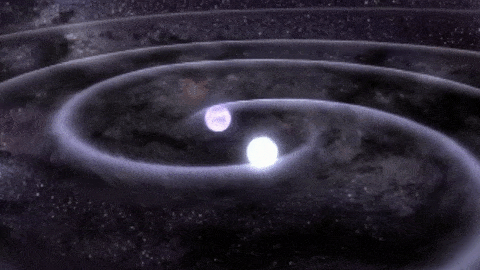
The Sun’s Orbit Brings Energy Changes on Earth
Hindu astronomers noticed that as we move closer to or farther from the magnetic center of the Milky Way galaxy, energy and light bring huge changes in culture and consciousness on Earth. Ancient wisdom held that the Great Year brings powerful energy forces and electro-magnetic influences from the galactic center, and that this rules the rise and fall of civilization on Earth.
Ancient Oral Texts Preserved the Galactic Wisdom
Hindu masters encoded cosmology, astronomy and calendar history in sacred oral Sanskrit verses that were memorized, chanted, and passed down with each generation, in order to survive even the lowest ages of mankind. Modern scholars do not agree on the exact age of the Veda and the Purana texts. Their estimates of its age range widely from 5,000 years up to billions of years old!
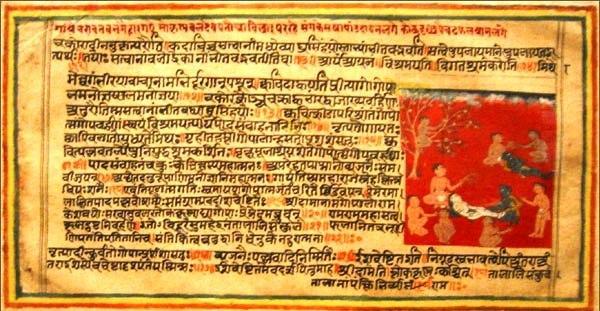
What are Yugas?
The Hindu calendar measures time cycles called Yugas or Ages. Hindu astronomers observed the Sun’s orbit and our changing relationship to the galactic center, called Vishṇunābhi Vishnu, in a cycle of 25,800 years. Ancient Hindu astronomers called it The Great Year and believed that the rise and fall of civilization is synchronized with Earth’s distance from the center of our galaxy. The Hindu calendar measures even larger cycles – for example, one Day of Brahma or Manvantara is one orbit around the entire galaxy of 4.32 billion years!
“Civilization is much older than commonly believed. Myths of a Golden Age of gods and advanced civilizations in the past are true stories of a real time period. Earth will eventually see another Golden Age. Now we’re in a Bronze Age moving into a period of greater enlightenment.” Swami Sri Yukteswar

There are four Hindu Yugas or Ages:
- Satya Yuga – Golden Age
- Treta Yuga– Silver Age
- Dwapara Yuga– Bronze Age
- Kali Yuga– Iron Age
A Full Cycle of Four Hindu Yugas is a ‘Great Year’.
A full cycle of ages consists of four expanding ages followed by 4 declining ages. Together these eight ages represent a full cycle of The Great Year, being about 25,800 years.
Cycles of Culture and Consciousness on Earth
Swami Sri Yukteswar explains that just as the cycles of day, night, and the four seasons are caused by celestial rotations, so too is the Yuga cycle, or the Great Year. This brings huge energy changes to life on Earth. Light and vibrations emanating from the galactic center affect the human mind and body.
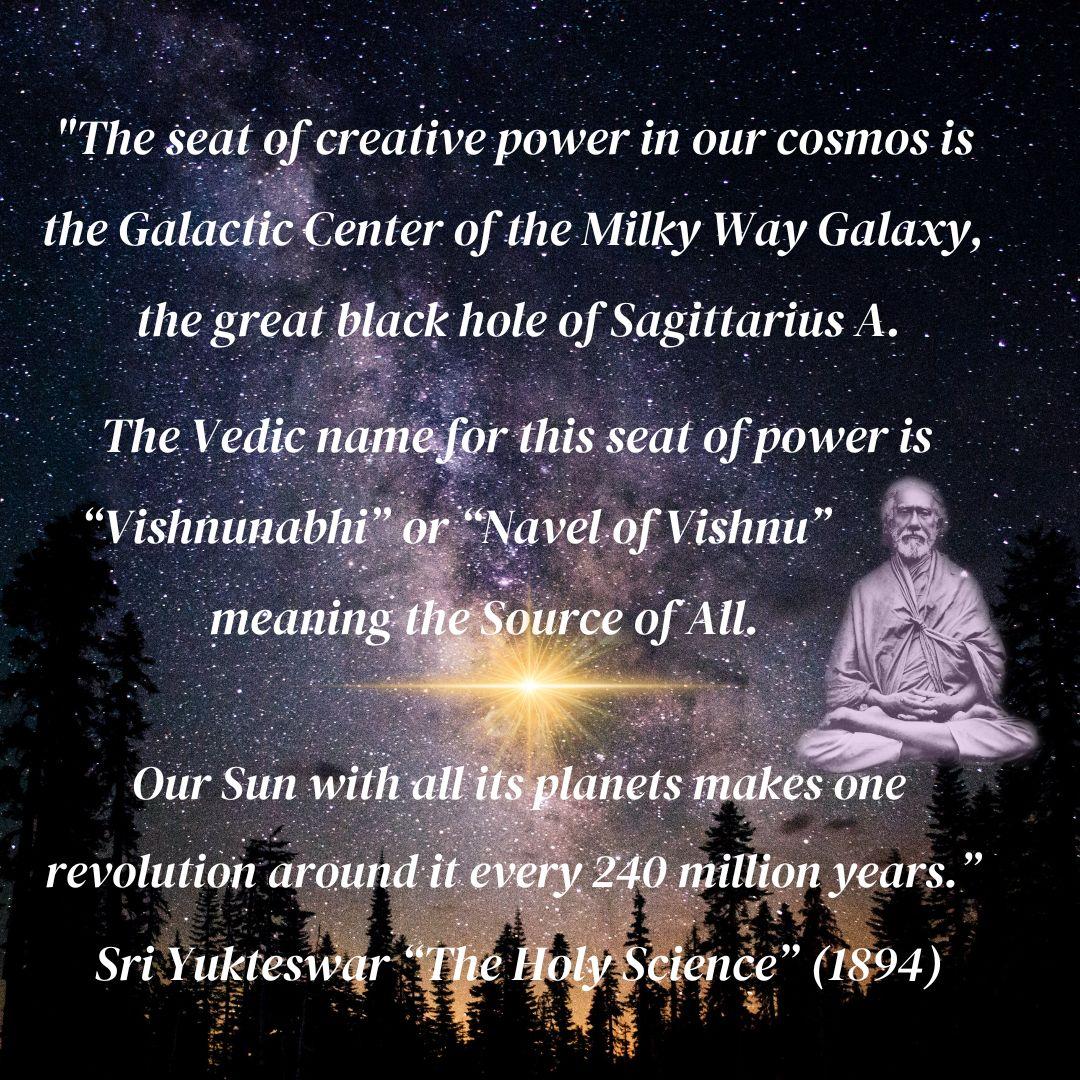 When our sun orbits through the galaxy, it is said to bring the Earth closer to or further away from the grand galactic center called Vishṇunābhi. This is the center of subtle energy and the creative power or Brahma which regulates the mental and spiritual level of the internal world. It is the proximity of the Earth and Sun to this grand center that determines the level of human civilization, health, intelligence and spiritual wisdom.
When our sun orbits through the galaxy, it is said to bring the Earth closer to or further away from the grand galactic center called Vishṇunābhi. This is the center of subtle energy and the creative power or Brahma which regulates the mental and spiritual level of the internal world. It is the proximity of the Earth and Sun to this grand center that determines the level of human civilization, health, intelligence and spiritual wisdom.
Why So Much Confusion about the Hindu Yugas?
Sri Yukteswar calculated the Yuga dates in his book The Holy Science. While they are often quoted, not all Hindu astronomers agree. Some people say we are in the Kali Yuga now. Sri Yukteswar wrote that the Yuga count is often misunderstood. He explains why:
“At the end of the last Bronze Age or Dwapara Yuga c. 700 BC, the reigning king, Maharaja Yudhisthira, was faced with the arrival of the dreaded and dark Kali Yuga. He left his throne to his grandson and retired to the Himalayas with all his wise men. Since no one in the court knew how to count the Yugas, and nobody wanted to announce the bad news, they began adding years to the Bronze Age Dwapara dates.
This has degenerated into a series of mistakes and miscalculations that lead many people to believe we are now in the Kali Yuga. Some people even maintain that the Kali Yuga lasts 432,000 years. Sri Yukteswar’s book has made great contribution to clarifying these confusions.
Yukteswar’s book describes the Kali Yuga: 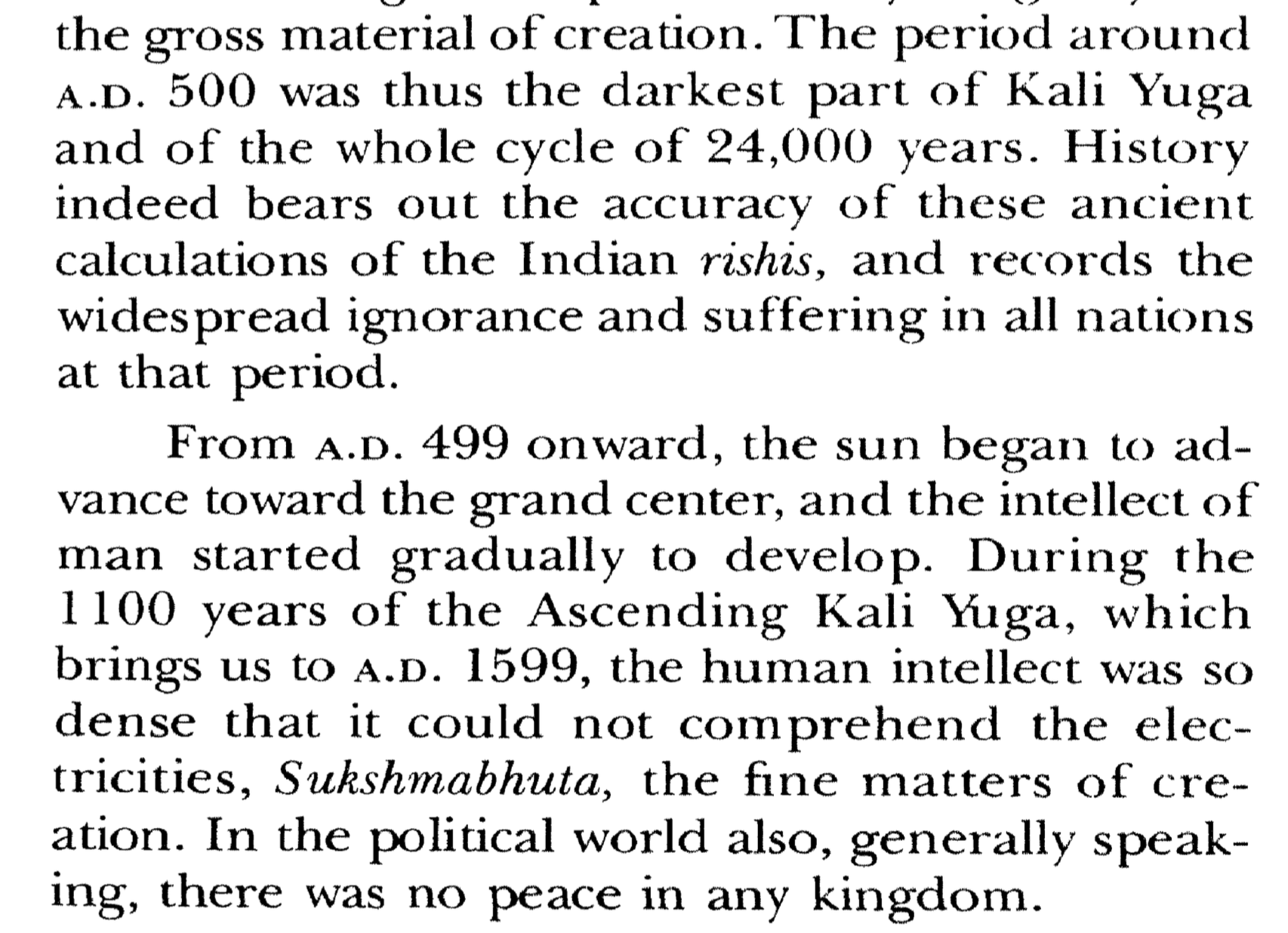
Sri Yukteswar says we Are Now in the Dwapara Yuga, not the Kali Yuga.
- The last Golden Age, Satya Yuga was 16300 – 6700 BCE, a time of the highest civilization.
- The last Silver Age, Treta Yuga was 6700 – 3100 BCE, as the level of culture began to decline.
- The last Bronze Age, Dwapara Yuga was 3100 – 700 BCE, in a continuing decline of civilization.
- The lowest Iron Age, Kali Yuga, from 700 BC – 1600 CE, declined into a time of greed, war, and disease.
- We are now in an expanding Bronze Age, Dwapara Yuga from 1600 – 4100 CE. This is said to be a period of expanding electrical, atomic and finer forces.
- The next Silver Age will be from 4100 – 7700 CE, an age of great expansion.
- The next Golden Age will be from 7700 – 12500 CE, an age of the highest spiritual culture.
The book describes our current Bronze Age or Dwapara Yuga:
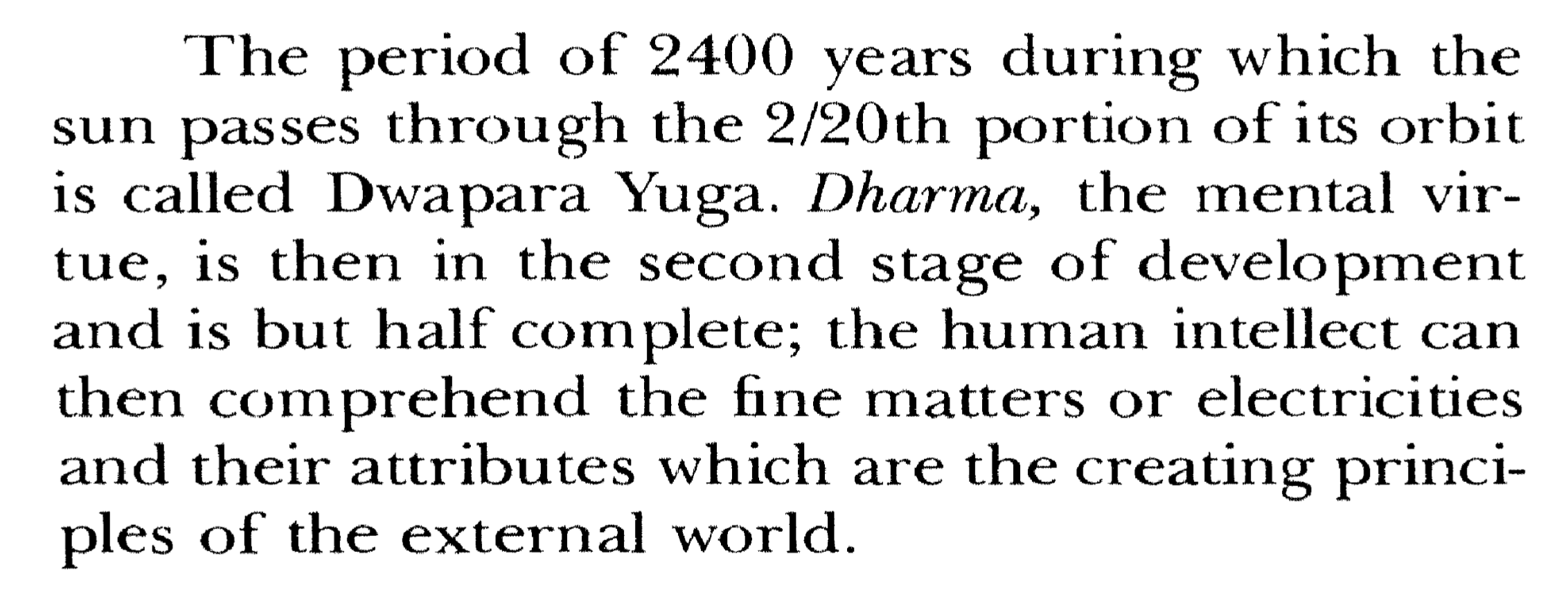
We can see evidence all around us that we are living in the beginnings of an expanding time. So I personally can accept Sri Yukteswar’s calculations. That would put the fall of the Roman Empire at the lowest point of the Kali Yuga in 500 CE. The slow ascension through the dark ages would have also been part of the Kali Yuga. Then the so-called Renaissance period of 14th to 17th century could be seen as the positive transition out of the Kali Yuga, leading into the beginning of the current Dwapara Yuga, Bronze Age.
Since 1600 CE, the Dwapara or Bronze Age clearly shows great acceleration and developments within the material realm including all areas of electricity, science and technology. In these times there is great focus on money and physical concerns, with just a few hints of widespread spiritual advancement.
Overall I find it reassuring that cycles are just part of the forever turning, and even huge cycles are not to be taken too seriously. Having the big picture gives us permission to relax and enjoy the ride up and down through the ages, without getting too excited about a few bumps along the road. What are your thoughts?
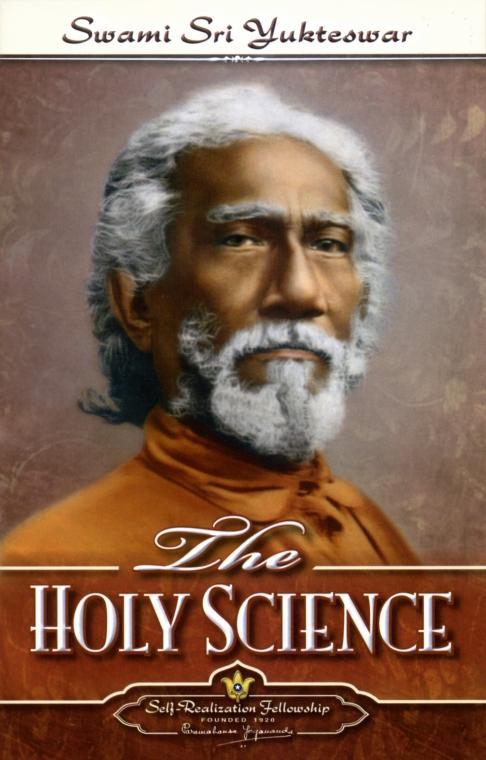
“Everything flows out and in.
Everything has its tides. All things rise and fall.
The pendulum swing manifests in everything.
The measure of the swing to the right is
the measure of the swing to the left.”
The Kybalion, Hermetic Texts
Resources:
http://www.starcenter.com/holy-science.pdf
The Holy Science by Swami Sri Yukteswar
The Secret Calendar Codes, by Caterina Schiavone


